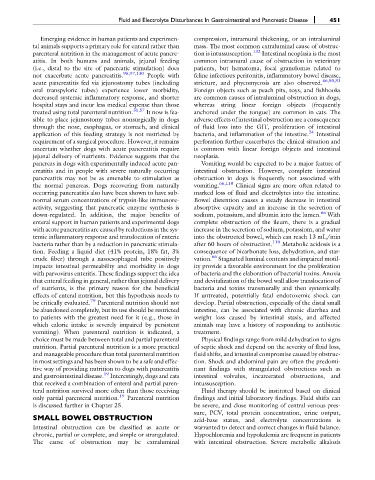Page 463 - Fluid, Electrolyte, and Acid-Base Disorders in Small Animal Practice
P. 463
Fluid and Electrolyte Disturbances In Gastrointestinal and Pancreatic Disease 451
Emerging evidence in human patients and experimen- compression, intramural thickening, or an intraluminal
tal animals supports a primary role for enteral rather than mass. The most common extraluminal cause of obstruc-
parenteral nutrition in the management of acute pancre- tion is intussusception. 132 Intestinal neoplasia is the most
atitis. In both humans and animals, jejunal feeding common intramural cause of obstruction in veterinary
(i.e., distal to the site of pancreatic stimulation) does patients, but hematoma, focal granulomas related to
not exacerbate acute pancreatitis. 95,97,130 People with feline infectious peritonitis, inflammatory bowel disease,
acute pancreatitis fed via jejunostomy tubes (including stricture, and phycomycosis are also observed. 46,80,81
oral transpyloric tubes) experience lower morbidity, Foreign objects such as peach pits, toys, and fishhooks
decreased systemic inflammatory response, and shorter are common causes of intraluminal obstruction in dogs,
hospital stays and incur less medical expense than those whereas string linear foreign objects (frequently
treated using total parenteral nutrition. 31,57 It now is fea- anchored under the tongue) are common in cats. The
sible to place jejunostomy tubes nonsurgically in dogs adverse effects of intestinal obstruction are a consequence
through the nose, esophagus, or stomach, and clinical of fluid loss into the GIT, proliferation of intestinal
application of this feeding strategy is not restricted by bacteria, and inflammation of the intestine. 24 Intestinal
requirement of a surgical procedure. However, it remains perforation further exacerbates the clinical situation and
uncertain whether dogs with acute pancreatitis require is common with linear foreign objects and intestinal
jejunal delivery of nutrients. Evidence suggests that the neoplasia.
pancreas in dogs with experimentally induced acute pan- Vomiting would be expected to be a major feature of
creatitis and in people with severe naturally occurring intestinal obstruction. However, complete intestinal
pancreatitis may not be as amenable to stimulation as obstruction in dogs is frequently not associated with
66,110
the normal pancreas. Dogs recovering from naturally vomiting. Clinical signs are more often related to
occurring pancreatitis also have been shown to have sub- marked loss of fluid and electrolytes into the intestine.
normal serum concentrations of trypsin-like immunore- Bowel distention causes a steady decrease in intestinal
activity, suggesting that pancreatic enzyme synthesis is absorptive capacity and an increase in the secretion of
down-regulated. In addition, the major benefits of sodium, potassium, and albumin into the lumen. 66 With
enteral support in human patients and experimental dogs complete obstruction of the ileum, there is a gradual
with acute pancreatitis are caused by reductions in the sys- increase in the secretion of sodium, potassium, and water
temic inflammatory response and translocation of enteric into the obstructed bowel, which can reach 13 mL/min
bacteria rather than by a reduction in pancreatic stimula- after 60 hours of obstruction. 110 Metabolic acidosis is a
tion. Feeding a liquid diet (41% protein, 18% fat, 3% consequence of bicarbonate loss, dehydration, and star-
crude fiber) through a nasoesophageal tube positively vation. 66 Stagnated luminal contents and impaired motil-
impacts intestinal permeability and morbidity in dogs ity provide a favorable environment for the proliferation
with parvovirus enteritis. These findings support the idea of bacteria and the elaboration of bacterial toxins. Anoxia
that enteral feeding in general, rather than jejunal delivery and devitalization of the bowel wall allow translocation of
of nutrients, is the primary reason for the beneficial bacteria and toxins transmurally and then systemically.
effects of enteral nutrition, but this hypothesis needs to If untreated, potentially fatal endotoxemic shock can
be critically evaluated. 79 Parenteral nutrition should not develop. Partial obstruction, especially of the distal small
be abandoned completely, but its use should be restricted intestine, can be associated with chronic diarrhea and
to patients with the greatest need for it (e.g., those in weight loss caused by intestinal stasis, and affected
which caloric intake is severely impaired by persistent animals may have a history of responding to antibiotic
vomiting). When parenteral nutrition is indicated, a treatment.
choice must be made between total and partial parenteral Physical findings range from mild dehydration to signs
nutrition. Partial parenteral nutrition is a more practical of septic shock and depend on the severity of fluid loss,
and manageable procedure than total parenteral nutrition fluid shifts, and intestinal compromise caused by obstruc-
in most settings and has been shown to be a safe and effec- tion. Shock and abdominal pain are often the predomi-
tive way of providing nutrition to dogs with pancreatitis nant findings with strangulated obstructions such as
and gastrointestinal disease. 19 Interestingly, dogs and cats intestinal volvulus, incarcerated obstructions, and
that received a combination of enteral and partial paren- intussusception.
teral nutrition survived more often than those receiving Fluid therapy should be instituted based on clinical
only partial parenteral nutrition. 19 Parenteral nutrition findings and initial laboratory findings. Fluid shifts can
is discussed further in Chapter 25. be severe, and close monitoring of central venous pres-
sure, PCV, total protein concentration, urine output,
SMALL BOWEL OBSTRUCTION acid-base status, and electrolyte concentrations is
Intestinal obstruction can be classified as acute or warranted to detect and correct changes in fluid balance.
chronic, partial or complete, and simple or strangulated. Hypochloremia and hypokalemia are frequent in patients
The cause of obstruction may be extraluminal with intestinal obstruction. Severe metabolic alkalosis

